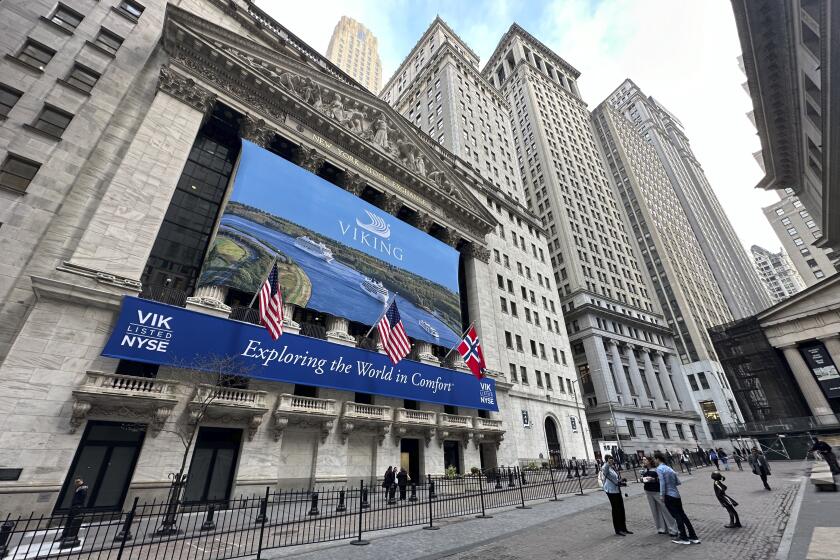Money flows on faith in the Fed
The idea of a global money glut -- investors worldwide having more capital than they know what to do with -- has been a powerful theme underpinning financial markets in recent years.
It’s a simple explanation for why domestic and foreign stock prices have continued to rise, why bond yields have stayed surprisingly depressed and why many investors have taken on ever-greater risk in a search for greater returns on their money.
Cash is in ample supply and credit is relatively easy. That’s a bullish mix for markets.
The capital glut is partly a function of the profit generated by the global economic expansion. But it also couldn’t exist without the accommodation of the Federal Reserve and the world’s other major central banks, which are the gatekeepers of money and credit in their economies.
Even though the central banks have been tightening credit, they’ve obviously left huge sums of money sloshing around out there, which is what has been pouring into markets from Wall Street to Moscow to Jakarta.
But those markets now face reminders that central bank policymakers may yet try to put a bigger dent in the capital glut by making credit more costly.
The European Central Bank on Thursday raised its key short-term rate to a five-year high of 3.5%, from 3.25%, and left the door open for more increases next year.
The Bank of Japan, which has tightened credit twice this year, is poised to do so again, perhaps at its meeting Dec. 19.
Fed policymakers will meet Tuesday, their final gathering of 2006. Although they appear certain to hold their benchmark rate steady at 5.25%, as they have since June, they may use their post-meeting statement to again warn that they may not be finished raising rates.
That has been the message from Chairman Ben S. Bernanke and other Fed officials in their public comments in recent weeks. They’ve made clear that they’re still concerned that underlying strength in the economy might push up inflation, which would oblige the Fed to lift rates further.
“They’re trying to say, ‘Please don’t get too optimistic here’ ” about lower rates, said John Makin, an economist at the American Enterprise Institute in Washington.
Yet the markets have acted as if Bernanke & Co. soon will be hacking away at interest rates. The annualized yield on the three-month Treasury bill, which normally stays close to the Fed’s benchmark, has slid under 5% in recent days.
Longer-term Treasury bond yields hit 10-month lows early last week, before rebounding somewhat Friday after the government’s report on November employment trends painted a relatively upbeat picture of the economy -- the same picture the Fed has been painting.
Despite the uptick Friday, the 10-year T-note yield, at 4.55%, is down from 5.24% in late June, and is 0.70 of a point below the Fed’s key rate.
Low bond yields have helped to bolster share prices; the New York Stock Exchange composite index and a number of other broad market indexes hit record highs early last week.
The markets seem to be supremely confident that the Fed is finished raising rates, and that the next move will be a cut.
But there’s another possibility: It could be that many investors aren’t betting on rate cuts in 2007 so much as they just figure that central bankers aren’t going to kill the global economic expansion, or dry up the capital glut, even if short-term interest rates move a bit higher.
There is a virtuous circle at work here: The longer the economy prospers, inflation stays subdued and markets are cheery, faith in policymakers grows.
In turn, investors’ high level of trust in the Fed and other central banks means the latter can feel free to continue their slow-motion pace of tightening credit, says Anthony Chan, chief economist at JPMorgan Private Client Services in New York.
“They don’t have to hit the markets with a sledgehammer” to make their point about controlling inflation, he said.
The Fed, the European Central Bank and the Bank of Japan all have been moving rates up in quarter-point increments, a comfortable pace that has, by all indications, left plenty of money out there for investment.
And because markets aren’t worried that the central banks will spring a surprise -- say, a half-point or larger rate increase -- people feel freer to take more risk in their portfolios, such as by buying securities (or entire companies) with borrowed money. The unimpeded use of credit adds to the global capital glut.
Not everyone is so sanguine about this state of affairs.
James Grant, editor of Grant’s Interest Rate Observer newsletter in New York, believes that risk-taking has reached the red zone, or beyond, in some markets, including securities backed by so-called sub-prime mortgages. That market was jolted last week as investors began to rethink how many of those loans might go bad in 2007.
Typically, it’s exactly when people drop their guard about investment risk that something happens to remind them of what can go wrong. Recall the sudden plunge in stocks worldwide from mid-May to mid-June after the Fed signaled that it wasn’t done raising rates to combat inflation. (Sound familiar?)
What if the Fed still isn’t done? Michael Darda, economist at investment firm MKM Partners in Greenwich, Conn., says he is sticking with his view that the Fed will have to raise its benchmark rate to 6% next year to restrain inflation pressures.
If he’s right, Darda says, long-term interest rates are seriously mispriced. A 30-year Treasury bond now pays an annualized yield of about 4.65%. Who’s going to accept that low a long-term yield if risk-free short-term rates are near 6%?
But people have been asking some variation of that question for the better part of the last two years. Yet long-term interest rates have stayed remarkably low, and the bull market in stocks has powered ahead, even as the Fed has tightened.
The message simply may be that central banks would have to do a lot more damage with short-term rates to break the virtuous circle -- and to drain away the glut of money that has global markets riding high.






